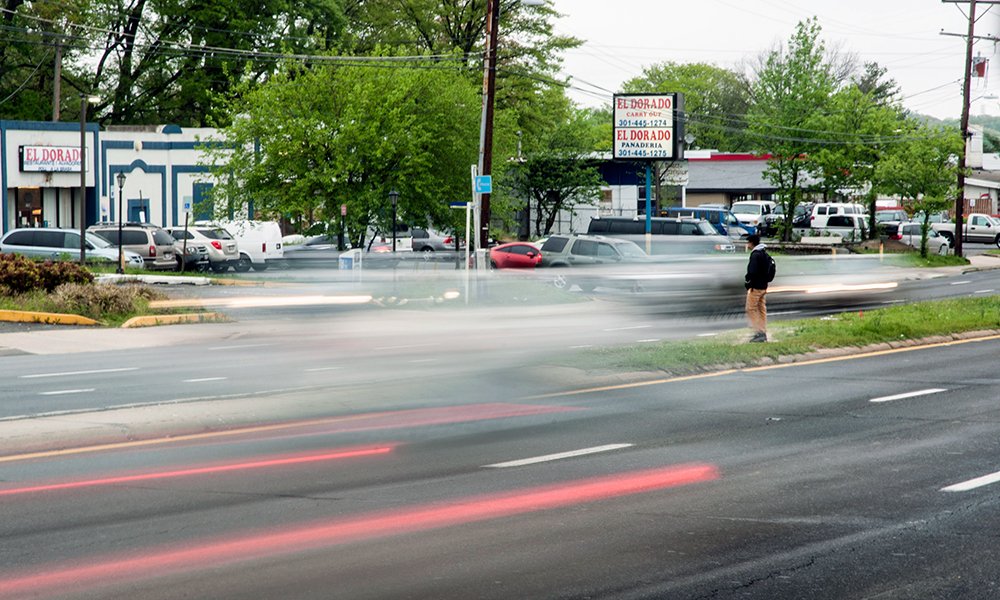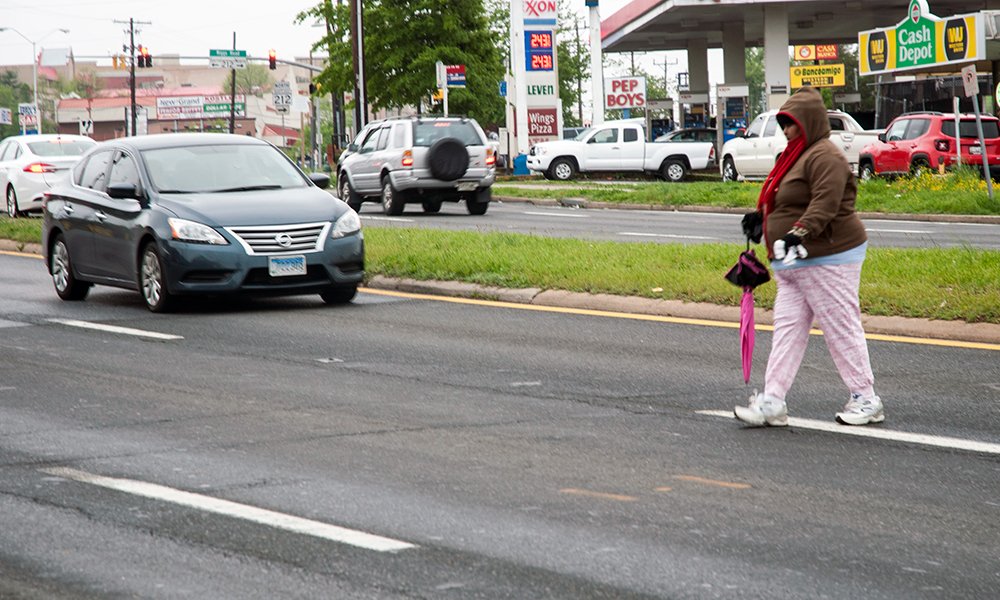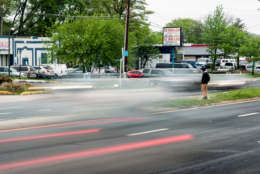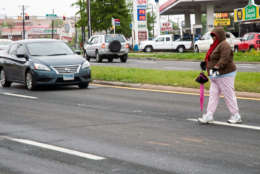



LANGLEY PARK, Md. — At least 138 pedestrians have been struck by vehicles in the past eight years on a lethal 2-mile stretch of state highway that runs through this low-income immigrant community. Eight have died.
By luck, Vanessa Harris wasn’t one of them. On a drizzly morning in April she balanced on a 4-foot-wide concrete median strip on University Boulevard, worrying she might “slip and fall and get hit” as three lanes of cars whizzed by her on either side.
She was coming from Dunkin’ Donuts, where she’d grabbed a cup of coffee while on a short break from her job at a variety store across the highway.
A moment later, she saw an opening and dashed across, making it safely to the other side.
Nine months earlier, 20-year-old Santos Udiel Romero died while crossing the highway in nearly the same spot. Two cars narrowly missed him before a Prince George’s County Police cruiser hit him.
On the same day, a vehicle hit a 37-year-old unidentified man crossing the street about 300 feet away. He suffered serious injuries.
Not designed for walking
A Capital News Service analysis of state accident data from 2009 through 2016 documented the casualties on University, a roadway that officials say wasn’t designed for the walking community now living along it in an unincorporated area of Prince George’s County.
The number of pedestrians hit by vehicles rose from 12 in 2009 to a high of 27 in 2012 and has lingered in the mid- to upper-teens for each of the past three years.
In addition to the eight fatalities, about half of the pedestrians struck by vehicles sustained serious or disabling injuries.
Yet the Maryland State Highway Administration has done little to improve safe passage for pedestrians on all but a small portion of University in Langley Park.
Crosswalks remain few and far between and provide little protection from turning cars. Narrow sidewalks put walkers perilously close to speeding cars. Fourteen people were on sidewalks when hit. Fifteen were on bicycles.
“It’s dangerous,” said Harris, who explained that she rarely risks crossing the street out of fear she will be hit by a car. “They need the pedestrian signals.”
In response to CNS’s findings, State Sen. Victor Ramirez, D-Prince George’s, who represents Langley Park, said that it may be time to “have a conversation” with the State Highway Administration about ways to better protect pedestrians.
But when asked about the high number of casualties, Charlie Gischlar, a spokesman for the State Highway Administration, which is responsible for maintaining University, said pedestrians are often to blame.
“A lot of these were unfortunately attributed to pedestrian error, okay?” Gischlar said. “We are going to do everything we can from an engineer standpoint, but there also has to be an onus on behavior as well. We’re willing to work with people but there also has to come a point with responsibility.”
The agency had a markedly different response when students were hit in a series of accidents just a couple miles away, near the University of Maryland in 2014. The State Highway Administration committed to swift and comprehensive safety improvements within months.
“No one really cares,” said Jorge Sactic-Espana, a community leader and member of the Langley Park Small Business Association. He runs a bakery in La Union Mall that fronts University Boulevard. “It’s as simple as that. If somebody yells in Bethesda or Chevy Chase, they do it right away, you know? But here, who cares, you know?”
Dangerous crossing
As Oliver Vargas looks out the window by his desk in the leasing office for the Bedford and Victoria Station apartment complex, he sees scores of people dodging traffic across University each day.
The bus stop drops people off outside the office near 14th Avenue and across from a shopping mall and restaurant. There is no traffic signal. The closest crosswalks are more than 500 feet in one direction and 1,000 in the other.
At least 12 people have been hit near 14th since 2009.
“There’s no light, no cross sign, it’s really bad,” Vargas said. “It’s hard to judge the speed of a car and it takes one or two seconds for you to misjudge and get hit.”
The State Highway Administration estimates 32,000 vehicles on average travel through Langley Park each day on University — a segment of MD-193, which snakes through the Maryland suburbs outside Washington.
To the west of Langley Park, the highway traverses a mostly residential area with a sprinkling of businesses. To the east it narrows from six lanes to four bordered by park land, the University of Maryland and its golf course.
But the two miles that cut through Langley Park are flanked by a chaos of strip malls, apartment complexes, single-family homes, grocery stores, gas stations, laundromats and fast-food restaurants.
Christopher Murtha, deputy chief of patrol for Prince George’s County Police, described the community “as a very dense population of folks who tend to use the sidewalks and tend to transit by foot…. It’s really an anomaly for our county.”
The highway wasn’t engineered for so many pedestrians, he said, so reducing accidents is a challenge for the state and county agencies that share responsibility for pedestrian safety.
Originally settled by returning WWII veterans, Langley Park today is a working class community of about 19,000. Three quarters of its residents are Hispanic, 65 percent are foreign-born, many from Central America. The median household income is $56,875, compared to the state median of $74,551.
It’s a landing place for newly arrived immigrants from countries with different rules of the road that may not include crosswalks, said Danitza Simpson, director of the Adelphi/Langley Park Family Support Center, an education organization. She suggested lowering speed limits, installing fences in medians and posting more warning signs in different languages. “That would help.”
A planned inter-county light rail system, the Purple Line, which would pass through Langley Park on University, helped spur pedestrian safety improvements at one busy intersection, New Hampshire and University. The Maryland Transit Authority opened a new bus transfer station there in December to make connections easier and safer. Median fences have been in place at the intersection for years to steer pedestrians toward crosswalks protected by signals.
Yet accidents are endemic outside the fences.
“What it comes down to is we need people to cross at marked crosswalks and we do have a lot of marked crosswalks in that corridor there,” said Gischlar of the State Highway Administration, adding that “a lot of people are crossing at night in dangerous locations.”
But the CNS analysis found that of 138 pedestrians struck by vehicles since 2009, about half were hit during daylight hours, according to the records.
A third occurred in the middle of long stretches without crosswalks. There are nine signal-protected crossings in Langley Park, but four are clustered around the new transit center at the New Hampshire intersection, leaving long gaps elsewhere.
For example, there’s nearly half a mile between Riggs Road and the next nearest crosswalk to the east at 23rd Avenue. More than a dozen pedestrians have been struck in between.
Jose Daniel Cubias-Rivera, 40, was among them. A car hit him as he crossed on a summer evening in 2010. The motorist sped away, leaving Cubias-Rivera lying in the roadway, according to Prince George’s County Police. He would later die at the hospital from his injuries.
From 23rd, it’s another quarter mile to a crosswalk at West Park Drive. In between, a densely populated residential subdivision sits across from two large supermarkets. Rather than trek bags of groceries to a distant signal, people often weave through traffic at the unprotected midpoint. Vehicles have struck at least seven pedestrians in that vicinity.
Accidents at crosswalks
The analysis also found accident clusters at intersections with crosswalks.
Twenty people have been struck in or near the faded crosswalks at 23rd, where cars pull in and out of a popular thrift store, a McDonald’s restaurant and two gas stations. At least seven were hit in the crosswalk while obeying the pedestrian signal, state records say.
Two dozen pedestrians have been hit in or near the 15th Avenue crosswalk, including a 36-year-old woman last May who was seriously injured when a car turned in to her as she crossed legally with the walk light.
Dinorah Franco, owner of D’Franco Family Hair Salon on University near Riggs, said the crosswalks there are so “very dangerous” that she often drives her car to the other side of the street instead of walking.
“There’s cars coming south, east and west and also turning,” said Franco, 61, a Dominican immigrant. “The cars, they have a right turn, left turn. It would be nice if we had a pass (pedestrian bridge) that we could go across.”
In addition to the 138 pedestrians struck on University, the CNS analysis identified an additional two dozen pedestrians who were hit on Riggs or New Hampshire within 105 feet of the intersections with University between 2009 and 2016. None were killed.
Murtha of the Prince George’s County Police said the department periodically cracks down on jaywalkers and speeding motorists in Langley Park with campaigns that have yielded nearly 4,000 traffic citations in 2015 and 2016. But enforcement alone isn’t enough, he said.
“We can’t police forever and educate every generation,” he said. “Eventually an engineered solution is the best long-term solution.”
Repeated accidents at the same locations point to a problem with the road design, not the pedestrians, said Alex Dodds, communications director at Smart Growth America, a nonprofit urban planning organization.
“That’s not a funny coincidence,” she said. “That’s a sign that the street is fundamentally not working for people who are walking.”
The organization published a study in January that found pedestrians in low-income urban communities face greater risks than those in wealthier ones, and that Hispanics and blacks were overrepresented in pedestrian fatalities.
“Fighting for better resources takes time, money, and political engagement — and all of those are usually scarce in low-income and immigrant communities,” Dodds said.
Elizabeth Villalobos, who is originally from El Salvador, has lived in Langley Park for about 30 years now and remembers calling an ambulance for two different pedestrian accidents in the last 12 years.
“I’ve seen a lot of them, a lot of accidents. … It makes me feel horrible but what am I going to do? It’s sad to see it,” Villalobos said through a Spanish interpreter. “What I do is, I just take out my phone and call the ambulance to help.”
“Someone needs to step in”
A couple of miles from Langley Park’s deadly stretch are four college bars, just off the University of Maryland’s campus by the intersections of Route 1 and Knox and Hartwick Roads. On any given weekend, students wait in lines that swell onto the sidewalk, while others dart across the four-lane street to catch up with friends.
This high concentration of people bar hopping and consuming alcohol was the scene of three fatal pedestrian accidents from January through July 2014. The three deaths were part of a string of eleven accidents in the area during this time.
City and university officials expressed their grief and desire for change in the months following the first incident and set out to lobby for roadway improvements.
Their voices were heeded.
They pressed State Highway Administration officials and won a slew of changes that were made to the road including a $191,000 investment for fencing and a new pedestrian signal. Other changes included reducing pedestrian wait times at signals, lowering the speed limit to 25 mph in this area and increasing use of speed cameras. No pedestrians have died since then.
Officials representing Langley Park have shown no similar sense of urgency.
A spokeswoman for Deni Taveras, the Prince George’s County Council member whose district includes Langley Park, said she did not have time to discuss the CNS findings on pedestrian accidents. In an earlier interview, she said pedestrian safety “has improved significantly” there and will continue to improve if and when the Purple Line is built.
A decade ago, the Metropolitan Washington Council of Governments and the National Capital Region Transportation Planning Board produced a pedestrian safety assessment for University that recommended slowing traffic with raised crosswalks, narrowing car lanes, widening medians and prohibiting right turns on red.
But the focus was on the intersection with New Hampshire Avenue. The State Highway Administration hasn’t made even relatively easy improvements to the rest of University.
CNS requested current and past pedestrian safety projects in Langley Park on University from the State Highway Administration, other than those around the transit center. The agency provided a list of four restriping projects since 2012.
Throughout much of Langley Park, median strips remain narrow to accommodate turn lanes into parking lots and side-streets. There are no raised crosswalks. The speed limit is 35 miles per hour, with no speed cameras to enforce it — only a sign warning motorists to watch for pedestrians.
State law limits speed cameras to construction work zones and school zones — or within a half mile of “the grounds of a building or property” used by a university or college.
There are no school zones on University, and most of the community lies just outside the University of Maryland’s half-mile protection zone. But there is one stretch that appears to qualify for a speed camera — leading into the accident-prone Lewisdale neighborhood. It’s about a third of a mile from the property line of the graduate student housing complex at the University of Maryland’s western entrance.
When asked why there was no speed camera, Prince George’s Police officials applied a different measurement. Rather than measuring from the property line, as allowed by the law, they measured from an internal street address on the grounds, placing Lewisdale at 0.6 miles from the university — just out of range.
In November, Prince George’s County officials sent a 13-page wish list of projects to the Maryland Department of Transportation for the next five years. The list includes planning for pedestrian safety improvements on University in Langley Park — with a note that says it’s “critical to improve pedestrian safety” before the Purple Line’s completion.
Lora Rakowski of the State Highway Administration wrote in an email that once the Purple Line project begins, University can expect to see “large-scale pedestrian and traffic-calming improvements.” The project includes plans for lane reduction from six lanes to four, new sidewalks, median fencing and new crosswalks at intersections with signals, Rakowski wrote.
That could be five years from now, if the project stays on schedule.
The pedestrians of College Park got faster action with the help of the state flagship university’s influential president, Wallace Loh. Along with city officials, Loh pushed for quick and comprehensive changes to ensure student safety.
“There’s a lot of focus and attention on making sure it’s a place that’s safe for families to send their kids to go to school,” College Park Mayor Patrick Wojahn said about the University of Maryland and its surrounding area.
Pedestrian fatalities “unacceptable”
The College Park accidents also caught the attention of Prince George’s County Executive Rushern Baker.
“Pedestrian fatalities on Route 1 and anywhere in Prince George’s County are unacceptable,” Baker wrote in a 2014 press release announcing a slew of reforms to Route 1 after the deaths of three pedestrians near the same College Park crossroad.
When asked about the difference in response to College Park and Langley Park, Baker said the College Park accidents were “highlighted” because they affected students. He put the onus on Langley Park’s residents to walk more safely and stressed the need for educational outreach.
“Especially in this area where many of our residents speak English as a second language, we want to make sure they are aware of what they need to do and how to stay safe,” he said.
David Brown, who lives in an apartment off of University, is used to seeing accidents there and said it doesn’t seem like officials care enough to make rapid safety improvements for residents of Langley Park.
“It will change at some point but someone has to actually do the footwork … an official, yes,” said Brown, who was born in Jamaica. “Someone needs to step in and say this needs to be done and addressed now, not later until five or six more people get killed before you do anything.”
— Julie Depenbrock, Lauraine Genota and Gabriela Martinez contributed to this article.







